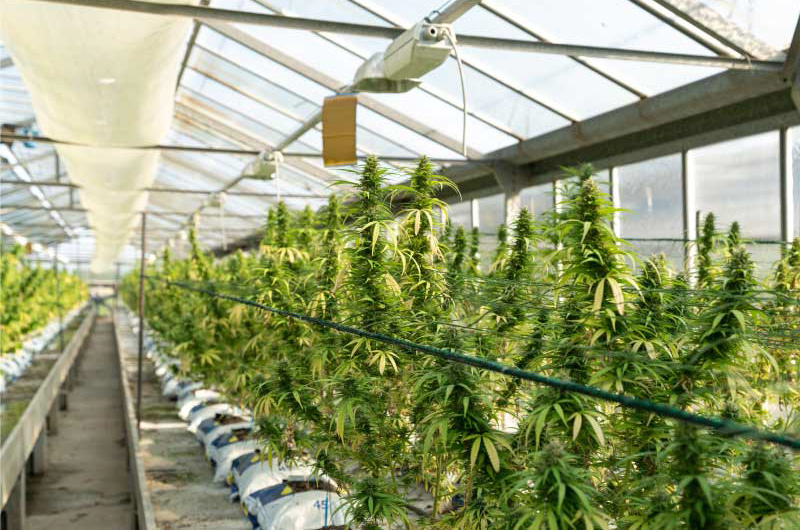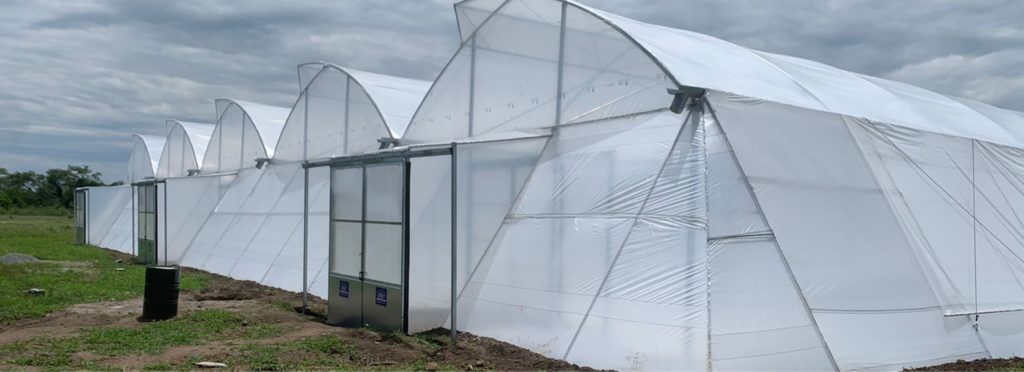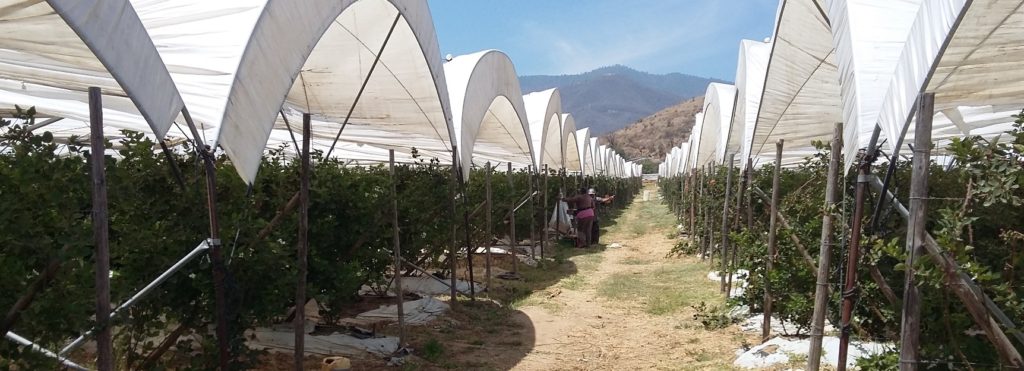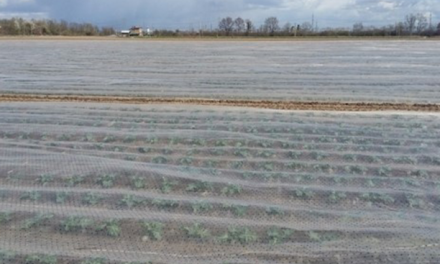
Cannabis cultivation under cover

Today, cannabis cultivation under covers can be considered a difficult topic of conversation because of the negative implications that are often associated with this plant. However, cannabis has achieved relevance because of its usefulness in the health sector and its medicinal contributions.
In this post we talk about:
- Why is cannabis viewed with suspicion in some countries
- What to consider when choosing plastic films for Cannabis cultivation under cover?
- What about the light spectrum in cannabis cultivation?
- Types of plastic for growing cannabis under cover
- What type of structure is recommended for cannabis cultivation under cover?
- What are the advantages of growing cannabis under cover?
- Is it necessary to know the cultivation area to be able to choose the most suitable materials for the crop?
- Can cannabis be grown anywhere?
- Latin America and its exponential growth in medical cannabis cultivation
- What is the future of cannabis?
Why is cannabis viewed with suspicion in some countries?
Although in some regions the negative perception of cannabis has changed over the years, since many of its compounds can help people with certain conditions such as glaucoma or epilepsy, in other countries its cultivation is still not allowed and is considered illegal due to the narcotic and addictive properties of some of the plant’s compounds.
According to studies carried out on the cannabis plant, out of its more than 500 organic compounds, 113 are cannabinoids, where CBD or Cannabidiol (which doesn’t provide psychotropic properties) and THC Tetrahydrocannabinol (which provides psychotropic properties) stand out.
Growers dedicated to the cultivation of medical cannabis focus on taking advantage of the CBD compound, present in the resin of the flower, estimating that 45% can be extracted in each plant.
Because CBD is non-psychoactive, it can be used to develop medications for patients in severe pain due to serious diseases such as cancer or multiple sclerosis, as well as other conditions such as fibromyalgia.
In addition to its medicinal purposes, today you can find other products made with cannabis such as oils, pills with a mixture of different components, personal hygiene products such as shampoos, and even makeup.
What to consider when choosing plastic films for Cannabis cultivation under cover?
When growing cannabis under plastic covers it is very important to consider, among other aspects, what types of plastic films are available on the market and to know how to choose the most suitable ones to enhance the quality of the crop. In this way, we can achieve the best possible results.
Although the land where the crop will be grown is the first thing that growers usually look at, other factors play a crucial role in the success or failure of a cannabis crop under covers, and we mention some of them below:
- The solar radiation in the area
- The climate
- The temperature
- The humidity
- The wind
- The amount of water needed by the crop
- The type of irrigation
According to Luisa Duque, Agricultural Engineer in charge of the Agricultural Plastics Division in Latin America of Armando Álvarez Group, before choosing a plastic film, the first thing to do is to understand the plant’s physiology. Unlike other species, cannabis plants consume more water, transpire a lot, and require specific lighting to avoid stress.
It is important to be clear about the demands of the land where the crop will be located, and the type of radiation in that specific area. In this way, it will be easier to acquire plastic covers that meet those requirements and provide benefits to the crop.
Duque explains that “Armando Álvarez Group manufactures plastics according to the country’s radiation, guaranteeing that the materials used in the field will last and fulfill their purpose. The plastic used in Mexico is different from the plastic that will be used in Ecuador or Chile. Radiation is different in each region; therefore, we have to be very careful about cannabis cultivation under covers to prosper.”
From an economic point of view, cannabis producers must be able to answer the following questions:
- To whom will they sell the product?
- When will they sell it?
- Where can they get the seeds?
- What type of structure is the most suitable to enhance cultivation?
- What is its long-term profitability?
What about the light spectrum in cannabis cultivation?
The light spectrum is one of the aspects with greater influence on the success or failure of a cannabis crop under covers.
To know how to grow cannabis under covers, it is necessary to learn how to manage the light spectrum, because we must guarantee a photosynthetically active light passage of 400 to 700 nanometers for this type of crop, otherwise, it is unlikely that the plant will perform the photosynthesis.
When the right plastic is chosen, two aspects can be manipulated: UV rays and the thermal part of the crop. In this way, up to 380 nanometers can be blocked, managing the occurrence of pests and diseases in the crop, as well as reducing the mobility of whiteflies and thrips, which are very common in crops under covers.
Duque points out that according to the specifications given to them by cannabis producers, they can develop plastics in which a window is opened in the UV filter part, from 280 to 320 nanometers, to obtain UV-open plastics. “The UV is extremely important because it will allow to increase the production of trichomes, and therefore, to obtain a greater amount of oil that can be extracted from the plant”.
Types of plastic for growing cannabis under cover:
As we mentioned before, for cannabis cultivation and, in this specific case, to choose the type of plastic we need, it is important to consider the following:
- Illumination
- Temperature and humidity
- Wind
- Irrigation
“The idea is to create plastics that adapt to the requirements of each specific crop. Some crops will need plastics with total light transmission qualities, others with partial light transmission, as well as others that allow maintaining humidity and controlled dripping; that is, you must know what the need is in the specific area where these plastics will be used,” says Duque.
Production characteristics for the crop, which will also affect the selection of the plastic:
There are ideal plastics for each phase, for example, plastics for germination with 85% total light transmission and 75% diffusion avoiding shading, plastics with 25% shading, as well as plastics for cultivation, and films for harvesting, or drying.
Plastics used during the cultivation phase:
-
Low diffusion plastics with shading mesh
This is a very transparent plastic that allows full visualization from the outside to everything inside. It has a total light transmission (90%), and it allows a homogeneous distribution of light between 20% to 35% (diffusion). When the shading net is installed, it produces shading in the crop and avoids direct light transmission.
-
Plastics with 55% or 75% diffusion
This is one of the most commonly used cover films in cannabis cultivation, especially in tropical areas. For these areas, the ideal choice is between two alternatives: UV-open plastics (280 to 320 nanometers), which allow more production of resins and trichomes in the flower or closed UV (380 nanometers), and plastics with high diffusion.
According to Luisa Duque, the importance of choosing UV-open plastics is that it is possible to obtain higher resin production and more trichomes in the flower. “They are a great help for both tropical and non-tropical crops. That way you boost all the UV available in that particular region,” she indicates.
With this type of plastic, you can also play with the shading since there are many areas where the radiation is higher, and by providing a more homogeneous shade, where it doesn’t interfere with the PAR light, the cannabis crop will be in better conditions to thrive and grow.
-
Plastics with 25% to 50% shading
The choice of shading capacity will depend on the radiation we have in the cultivation area. These plastics can be ideal for areas with very high radiation because they don’t interfere with PAR light (photosynthetically active light), they just provide better conditions for plant growth.
-
Thermal plastics
Thermal plastics are ideal for cannabis crops that are located in high altitude areas or where the climate tends to be colder and there are clearly defined seasons.
They help to take advantage of the infrared light spectrum to increase the temperature of the crop during the day, avoiding sudden temperature changes at night that could compromise the integrity of the crop.
-
Athermal plastics or cold plastics
Unlike thermal plastics, this type of plastic prevents part of the infrared light from entering the greenhouse, allowing the crop to have a stable temperature condition where there are no shocks that may affect the development of the plants.
They are ideal to maintain the temperature of the crop between 26 to 28 Celsius degrees or its equivalent of 79 to 82 Fahrenheit degrees maximum, but this will depend on the area where the crop is located.
Today, these plastics are totally transparent and no longer present any coloration as they did some years ago when they looked grayish. This quality creates the perfect scenario for the development of the crop since it doesn’t interfere with light transmission, and temperature control is ideal.
Plastics for the cultivation of harvested cannabis:
-
Bicolor plastics (green/black, white/black, white-black/silver)
These are ideal for the drying and curing process of the buds. In this phase, it is necessary to have the harvested product in the dark.
What type of structure is recommended for cannabis cultivation under cover?
Medical cannabis crops generally require an infrastructure with very specific characteristics since legally they must be very protected; also because these are crops that require a significant economic investment to thrive.
The most commonly used structure is the high-tech metallic greenhouse, where the floor is protected by agro-textiles of agricultural use, usually in white color to allow greater light reflection and to produce a photosynthetic effect beneficial for the cannabis plants.
There are structures where gray/silver shading screens are installed to help manage light and temperature, but it all depends on the need of that specific crop.
What are the advantages of growing cannabis under cover?
- The possibility of obtaining several harvests during a year: it is no secret that with cultivation done under structures such as greenhouses, plants grow better and faster, so in the case of cannabis it is generally possible to obtain four harvests per year.
- There is greater security in the management of the crop: especially in countries where cannabis cultivation is still in the phase of approval and legal adjustment.
- The conditions of the plants are better managed: in this way, up to three times more resin can be obtained, which is where the therapeutic properties of the plant are concentrated when the active compounds are extracted. Thanks to this extra resin obtained by enhancing the crop, there are higher profits for producers.
Is it necessary to know the cultivation area to be able to choose the most suitable materials for the crop?
Very necessary, since to obtain a successful cannabis crop it is essential to analyze the resources you have and what is required. Following are some of the issues you must consider:
- What type of structure do I need?
- What type of irrigation system can I use?
- What type of seed can I get? Is it available?
- What is the wind direction in the area?
- What is the radiation in the area? Is there enough water?
These are elements that, when considered, will allow you to make better decisions.
Regarding the plastics to be used, it is advisable to know the amount of light or radiation in the area so you can acquire what is really needed, instead of buying a random material. The idea is to cover the needs of the crop to optimize its development.
Can cannabis be grown anywhere?
One of the benefits of cannabis is that, by creating the ideal conditions for its development, it can be grown almost anywhere in the world.
For example, if the crop is located at sea level, it can perfectly prosper if the temperature, light, wind, and humidity of the crop are properly managed. It may turn out to be a little more difficult due to the location, but it is feasible.
In the case of a tropical area in America, the ideal scenario is to locate the crop at about 900 meters above sea level, but in the case of temperate countries, it would be necessary to review the levels of radiation and temperature to know if it is possible to grow cannabis in those conditions.
There are areas such as Bogota, Colombia, where due to its geographical conditions UV radiation has increased the development of the CBD compound in the plants. In this case, the ideal scenario is to use UV-open plastics and combine them with a suitable structure that will moderate the entry of light or control the radiation to obtain better production.
Latin America and its exponential growth in medical cannabis cultivation
Something that stands out about cannabis cultivation in Latin America is its growth over the years. One of the reasons behind it is that the area allows very affordable production costs, due to the cost of labor, and prior knowledge since cannabis had been grown illegally for many years.
The important thing is that there is a cultivation experience that, although it was not well regarded at the time, today we can take advantage of the same in the best possible way.
What is the future of cannabis?
The current perspective of cannabis is far from what it used to be some years ago since in many countries in Europe, North America, and Latin America it is now perceived as “green gold,” where a very high supply worldwide for its consumption and treatment is evident.
“Today we see that almost all countries have allowed its medical and recreational use in some way, and it is something that continues to increase. Although there are regions such as Asia and Africa, where it is still a complex issue, this will certainly change as we see that cannabis cultivation has many medicinal qualities that are beneficial for human health,” said Duque.
For more information about growing cannabis under covers, as well as agricultural plastics for cannabis cultivation, we recommend watching our webinar on Medical Cannabis and to contact us if you have any questions or requirements.
We invite you to read other posts related to cannabis:
- Legal use of marijuana, cannabis or hemp in Latin America
- Pest control in cannabis crops
- Cannabis fairs





![[eBook] Sustainability and water management](https://agriplasticscommunity.com/wp-content/uploads/8_550x310_ENG-440x264.png)
![[eBook Trends in Agriculture Plastics] Increasing use of biodegradable mulch](https://agriplasticscommunity.com/wp-content/uploads/550 × 310_2_ENG-440x264.png)
![[eBook Trends in Agriculture Plastics] Reducing the plastic used in the manufacture of agricultural films](https://agriplasticscommunity.com/wp-content/uploads/550 × 310_1_ENG-150x150.png)

























